French heavyweights. Tanks late for war
We have already written about the two super heavy tanks of France of this period. You can read about the amazing fighting machines, which Char 2C, also known as FCM 2C, and 140-ton FCM F1, of course, were in the article “Steel monsters: super heavy tanks of France". Today we will take a closer look at two other, no less surprising, French projects: the heavy tank FCM 1A, the layout of which was more familiar and peculiar to tanks of the Second World War rather than 1917, and the super heavy tank AMX “Tracteur C”, which in French terminology related to “fortress tanks” (Char de forteresse).
Heavy tank FCM 1A
History This tank originates in the summer of the year 1916. It was then that the French military were able to formulate all the qualities that they would like to see in a heavy tank. They did not want so much, but for those years their vision of the development of tanks was advanced. This is confirmed later by the light tank Renault FT-17, which became the first tank of the classic layout and a very successful combat vehicle actively exported. From the summer 1916 of the year, the French wanted: artillery towers, the ability to confidently overcome trenches and wrinkles, which Schneider and Saint-Chamons couldn’t boast, as well as normal counter-booking (by that time the Germans had already learned how to fight French tanks with their 77-mm field guns). Machine guns on a heavy tank planned to put as much as fit. In this case, the new heavy military vehicle was needed by the French military urgently, as they say, yesterday.
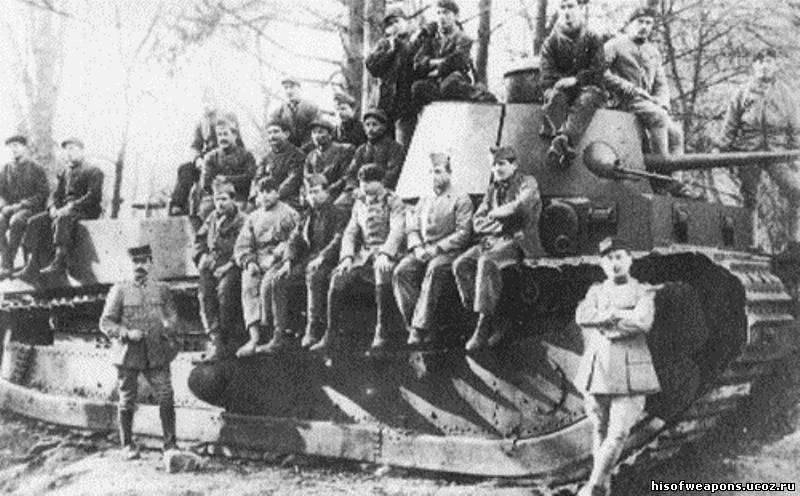
Against the background of the first French tanks, the project, which was presented by the Mediterranean Society of Railway Plants and Shipyards (FCM), looked much better. The company received an assignment to develop a heavy tank in July 1916 from the head of the Automotive Service Office of the French Army. Almost immediately after receiving the first information about the combat use of the British Mk.I tanks, the specialists of the French company FCM created their own tank design weighing more than 38 tons, armed with an 105-mm cannon and featuring 30-mm armor. On the tank it was planned to install the engine of the Renault company with the 200 horsepower.
Soon enough, the 30 of December 1916 of the year, the design of the tank, designated Char Lourd A, was submitted to the Advisory Committee of the Assault Artillery of the French Army. The efforts of the FCM engineers were rated positively, but the findings of the commission were not so optimistic. A preliminary assessment of this project showed that with a full set of weapons, ammunition and fuel, as well as with 30-mm booking, the mass of the tank will exceed 40 tons. With the technologies existing at that time, it was not possible to create a convenient and reliable mechanical type transmission for such a tank, so it was decided to create an electric transmission. This project was also developed by General Etienne, who offered two alternative tanks with 75-mm guns and different types of transmissions - electric and mechanical.
At the same time, the booking requirement remained unchanged, the tank had to be protected from being hit by German 77-mm field guns. Also, the experience of the combat use of the first French tanks showed that it was impossible to do without placing the main armament in a rotating turret; the same Saint-Chamond could direct its gun in a very limited sector, being more SPG than a tank. From this position, the tank tank with the 30-mm armor of FCM looked very dignified for its period of time.
The chassis of the tank did not differ special originality of design. According to the requirements, on a heavy tank, it had to be performed fairly high, practically human-like. The suspension of small-diameter support rollers was blocked, but the rigidity of the course was partly compensated by their number. The drive wheels were in front, the ridge gear guide wheels were behind. All open elements of the chassis were securely covered with armored screens.
Tank FCM 1A favorably distinguished classical layout. In front of his body was located the department of management, in which there were places of the driver and his assistant. Next was the combat compartment, on the sides of which there was one viewing device and two embrasures for firing from machine guns. 5 crew members were immediately located in the combat compartment: the tank commander, gunner, loader, machine gunner, and mechanic-mechanic. Thus, the crew of the tank consisted of 7 people. The engine and transmission compartments were located in the stern of the combat vehicle, occupying more than 50% of the entire length of the tank. The FCM 1A reservation was differentiated. So the tower and the frontal part of the hull had 35-mm booking, the hull and stern of the hull - 20 mm, the roof and the bottom of the hull - 15 mm. Observation devices on the tank was not enough. In the case of the combat vehicle there were 4 viewing slots covered with bulletproof glass (two in front and two on the sides). In addition, the tank commander could observe the battlefield with a commander's turret or a telescopic gun sight.
The composition of the armament of a heavy tank company FCM was impressive. In the tower of conical shape, which was located on the roof of the fighting compartment, it was planned to install 105-mm gun and 8-mm Hotchkiss machine gun. According to the project (and on the layout), another machine gun was supposed to be installed in a ball mount in the forehead of the hull with a slight offset to the left side of the tank, but this machine gun was missing on the built prototype. In addition, the Hotchkiss 4x8-mm machine gun, which could be used for embrasure shooting at the sides of the hull, was installed inside the fighting compartment.
Before building a prototype tank in metal, the French created a full-size wooden mockup. The mockup commission that examined the work was satisfied with what they saw. The appearance of the heavy tank FCM 1A was very impressive. At the same time, the combat vehicle received a rotating turret and a reservation that surpassed any of the English “rhombuses”. On the sea trials of the tank, which took place near the city of Seyne, the prototype was able to get December 10 1917. The 21-22 of December officially started the test cycle of the combat vehicle from a run on the road between the cities of Seyne and Sabletta, after which they decided to send the tank to the sandy beach. Due to the high running gear, FCM 1A relatively easily overcame obstacles, including: a vertical wall with a height of 0,9 meter, a trench with a width of 2 meter and a hole with a diameter of 3,5 meter. There were no obstacles for him and wire barriers, as well as small funnels from the shells. At full speed, a tank could knock down a tree with a diameter of about 35 cm. But the tank had obvious weak points that related to mobility. FCM 1A hardly managed cornering. The tank could move well only in a straight line. When trying to "turn the curve", the combat vehicle, due to the long length of the undercarriage and its small width, incomplete transmission and tracked vehicle design, could barely make turns even on a solid surface.
At the same time, the fire tests of the tank were very successful. Shooting from 105-mm guns proved its high efficiency in combat conditions, but they were still going to install 75-mm guns on production tanks. The choice in favor of a smaller caliber French military caused several factors: less impact when fired, smaller size guns and more portable ammunition, which was great. So, for 105-mm guns, 120 shells could fit in a tank, and for 75-mm 200 shells could fit. In addition, for each of the 5 machine guns there was from 2500 to 3000 cartridges.
Along the way, FCM engineers created two more versions of the FCM tank, 1В and FCM 1С. The last one was the hardest. Its mass should have already reached 62 tons, and its length increased to a 9,31 meter. At the same time, bookings and weapons remained unchanged. The FCM 1 version was made in the middle of the 1918 year, it was even planned to purchase 300 of such machines, but the capitulation of Germany and the end of the First World War led to the fact that the need for such a heavy breakthrough tank was no longer necessary in a war-torn France.
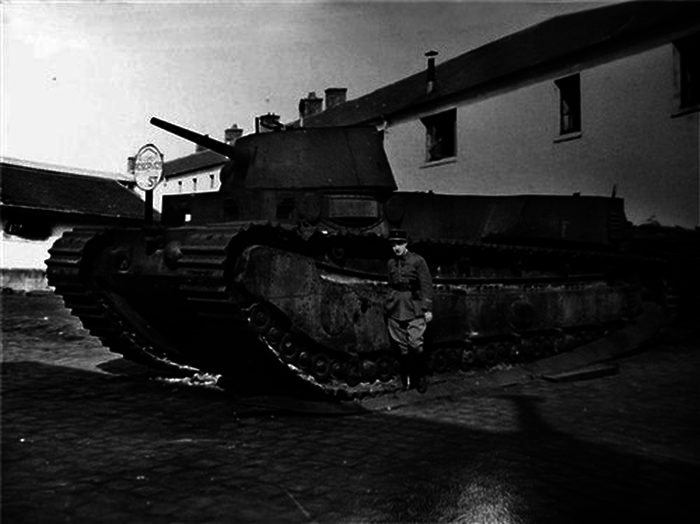
Despite this, the modified version of the 1С tank, which received the new Char 2C index, was launched into mass production several years later. The tank was released in a small batch. Char 2C so forever remained the crown of the development of heavy armored vehicles of the First World War, but the combat vehicle designed for a positional war was completely unsuitable for the Second World War, a motorized war, with rapid breakthroughs into the depth of defense, strategic envelopes and a race through the unprotected rear of the enemy. Late for the First World War, by the next war the heavy French tanks were hopelessly outdated.
Performance characteristics FCM 1A:
Overall dimensions: length - 8350 mm, width - 2840 mm, height - 3500 mm.
Combat weight - about 41 ton.
Reservations: the front of the tower and the front of the hull - 35 mm, the sides of the hull and feed - 20 mm, the roof of the hull and bottom - 15 mm.
Armament - 105-mm cannon or 75-mm cannon, 5x8-mm machine guns.
Ammunition - 120 shots for 105-mm cannon, 200 shots for the version with 75-mm cannon and more 12,5 thousands of cartridges for machine guns.
The power plant - 8-cylinder gasoline engine with horsepower 220-250.
Maximum speed - up to 10 km / h.
Cruising on the highway - about 160 km.
Crew - 7 man.
Super heavy assault tank or AMX "Tracteur C" tank fortress
In 1920-1930-ies, the French tank industry was struck by a long period of "stagnation", which was interrupted only before the start of the Second World War. However, this breakthrough did not mean that the theory of the use of tanks and tank units by the General Staff of the French Army was able to go as far as design thought. Possessing such a huge network of fortifications as the “Maginot Line”, the command of the French ground forces, until May 1940, was absolutely certain that it was simply impossible to break through this line of defense. Exactly the same they expected from the eternal adversary - Germany, which had its own "Siegfried Line". It was for the latter’s breakthrough, as well as the well-fortified defensive lines of the enemy in France, that designs were developed for tanks with large-caliber guns, which in British and German terminology were called assault tanks, and in French - “fortress tanks” (Char de forteresse). The horrors of the First World War trench warfare and the psychological trauma inflicted on it were so strong in France that several projects of fantastic mastodons were born that were supposed to break through any enemy defense.
In November of the 1939 of the year, when Poland had already fallen as the first victim of the outbreak of World War II, the General Staff of the French Army put forward technical requirements for the next "tank-fortress" that could overcome even the most well-fortified lines of defense. To do this, according to the generals of the old school, it was necessary to equip a combat vehicle with two-caliber guns in order to successfully fight different types of targets in a battlefield. The analogy with the multi-turret tanks being developed in the USSR is seen here, but the other requirements clearly went beyond the reasonable and led to the emergence of projects of such steel monsters as FCM F1 and AMX Tractuer C. The crushing and rapid defeat of Poland taught the French generals nothing.
The order for the development of the super heavy tank for AMX did not come as a surprise, although meeting all the requirements of the military even at the design stage seemed a daunting task. Its name "Tractuer C" received a new tank in order to secrecy. At the same time, the company worked on the project of the medium tank Tracteur B, which was more adequate and met the requirements of the time. According to the layout, the hull of the Tractuer C of the 1939 sample of the year was very similar to the “ancient” Char 2С, which was produced by FCM in a small batch. In the forward part of the combat vehicle there was a department of management in which there was a place for a driver (left) and a radio operator (right). In the front fighting compartment was planned to place the tank commander and loader. Behind them was located the power plant and transmission of the tank, and in the aft part of the machine it was planned to install a small gun turret and a place for the rear driver (!). The presence of the second mechvod in the stern was a relic of the First World War, as it was simply impossible to provide equivalent maneuvering of the tank forward and backward in those years, nobody could.
As the main weapons for the “tank fortress”, the 105 gun was most likely chosen, the Canone 105L mle1913, which was located in the main turret, the maximum diameter of which was 2,35 meters, and the SA47 35-mm cannon with a hemispherical shape in the stern of the hull, located with a slight shift to the right side of the central spine of the tank. Due to the substantial mass, the rotation of the main tower was planned using an electric motor. Additional weapons Tractuer C were to be 4x7,5-mm machine gun MAC31, which were placed on the sides in the front and rear parts of the body.
Reservation of the tank was planned quite impressive. The body of the welded structure had to be assembled from armor plates with a thickness up to 100-mm (forehead and sides), the likely booking of the main tower was within the same limits, the booking of the rear small tower was about 60 mm. The undercarriage of the combat vehicle was clearly a tank for the period of the First World War. Applied to each board, it consisted of small diameter 24 rollers, as well as 13 supporting rollers, a rear drive and front guide wheels.
The size of the Tractuer C tank was also appropriate (the length of the tracks - 9,375 meters, width - 3 meters, height - 3,26 meters), although in this respect it was not much different from the Soviet mastodon T-35. The weight of the AMX tank was estimated at 140 tons. In order to set in motion such a heavy machine, the tank was planned to be equipped with two engines, the power of which remained unknown, as well as an electric transmission. But the volume of the tank's fuel tanks was agreed immediately - 1200 liters.
The FCM F1939 and AMX Tractuer C tanks presented by the French military in December 1 aroused genuine interest among the army command, but recognized the winner as the first draft. Probably, the military commission considered the layout and placement of weapons on this tank more rational, but the main trump card of FCM at that time was the wooden layout of their combat vehicle. After losing the first round of combat, AMX engineers did not give up. Already in January 1940, they presented to the military a significantly redesigned tank project, which remained known as the AMX Tractuer C 1940.
The hull of the “tank fortress” has undergone major changes. As in the previous project, its construction was welded and assembled from 100-mm armor plates, however, the layout was completely different. The designers abandoned the stern of the small turret, as if from a relic of the past, it was transferred to the bow of the tank, which gave it a certain resemblance to FCM F1 and Soviet tanks T-100 and SMK. Fuel tanks and engines were moved to the stern of the tank hull. A combat compartment was placed in the middle part of the corps, on the roof of which a main ARL8 type tower appeared, with an 90-mm gun installed in it. In the small turret, which was now in front of the combat vehicle, just to the right of the driver's seat, the SA47 35 cannon was retained. Also preserved and 4x7,5-mm machine gun MAC1931 on the sides of the hull.
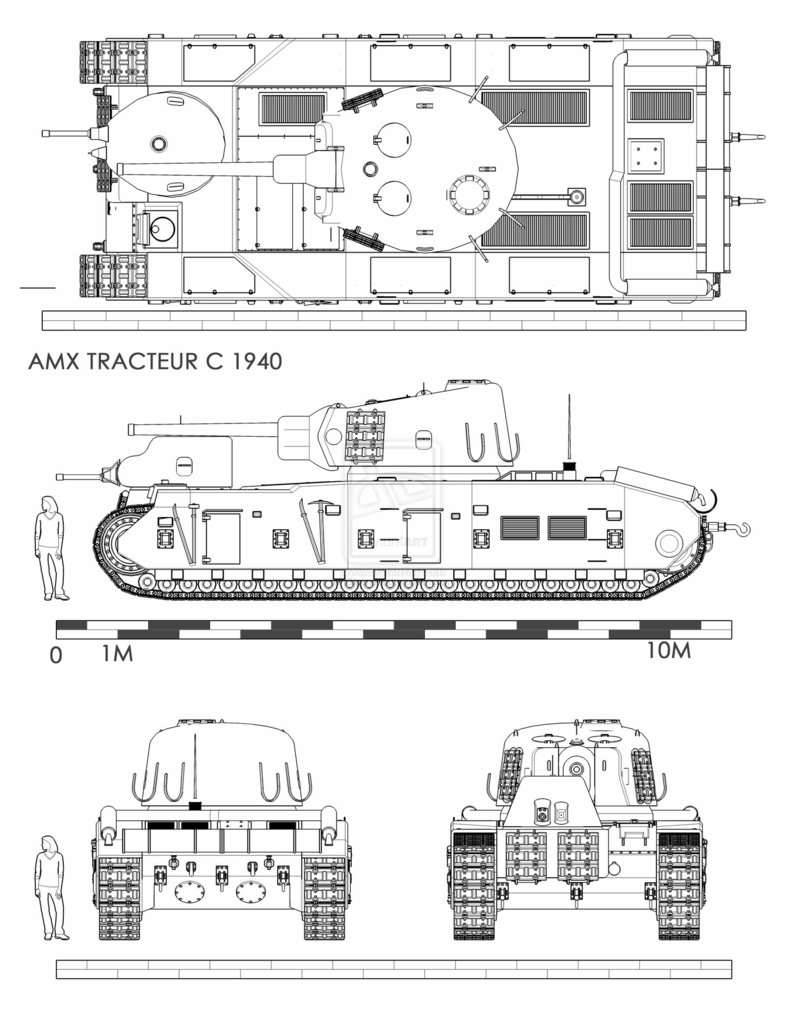
Due to the modifications of the project, the length of the tank increased, which resulted in improvements in the chassis. Now on each board accounted for already 26 track rollers. The overall dimensions of the Tractuer C of the 1940 model of the year were: length - 10 meters, width - 3,03 meters, height - 3,7 meters. However, the matter did not come to the realization of this project in the metal, although some prerequisites did exist. The French army commission, most likely for reinsurance purposes, allowed the FCM, ARL and AMX companies to produce one prototype on each other in order to carry out comparative tests of the vehicles - tanks had to pass the 1940 of the year by summer. In parallel, Schneider in January 1940 received an order for 4 towers for prototypes of future super-heavy tanks. It was stated that the towers would be made only for the installation of 105-mm guns. But it soon became clear that AMX was simply unable to provide the Tracteur C tank design for the 1940 summer, the project remained only on paper, and by the end of June 1940, France suffered a catastrophic defeat, becoming another victim of the German Blitzkrieg.
Even if this steel monster made it to the battlefields of World War II, a German war machine would go over it with a skating rink. The heavy tanks of France were not adapted for lightning war. These huge slow monsters were a great target for artillery and aviation the enemy. The famous "Stucks" would not leave stone on stone from these "turtles". Big claims were also to the running “centipede” with a large number of small road wheels and tracks from the aging B1 Bis tank. And it seemed that the French military and designers did not think about such issues as patency on soft and swampy soils.
Performance characteristics of AMX Tractuer C 1939:
Overall dimensions: length - 9375 mm, width - 3000 mm, height - 3260 mm.
Combat weight - about 140 tons.
Reservations - the forehead and the sides of the hull, as well as the main tower - 100 mm, aft tower - 60 mm.
The armament is one 105-mm Canone 105L mle1913 cannon, one 47-mm SA35 cannon and 4x7,5-mm MACX1931 machine gun.
The power plant - two carburetor engine (power and type unknown).
Fuel capacity - 1200 liters.
Crew - 6 man.
Information sources:
http://www.aviarmor.net/tww2/tanks/france/fcm1a.htm
http://www.aviarmor.net/tww2/tanks/france/amx_tracteur_c.htm
http://warspot.ru/3199-frantsuzskie-mastodonty-tanki-opozdavshie-na-voynu
http://strangernn.livejournal.com/869988.html
http://mihalchuk-1974.livejournal.com/193991.html
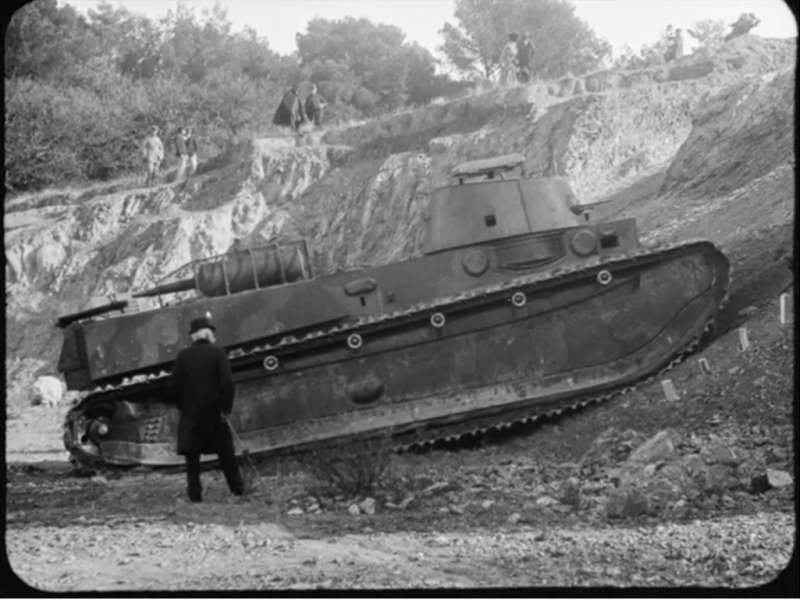
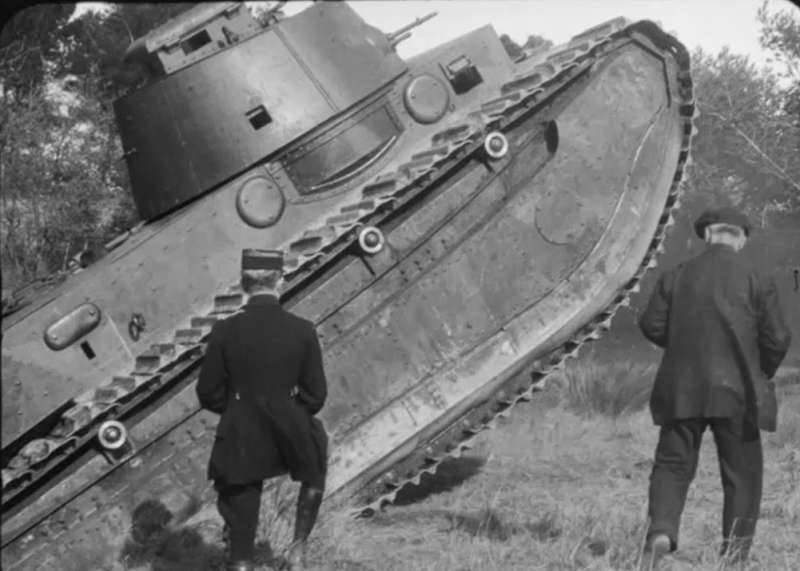
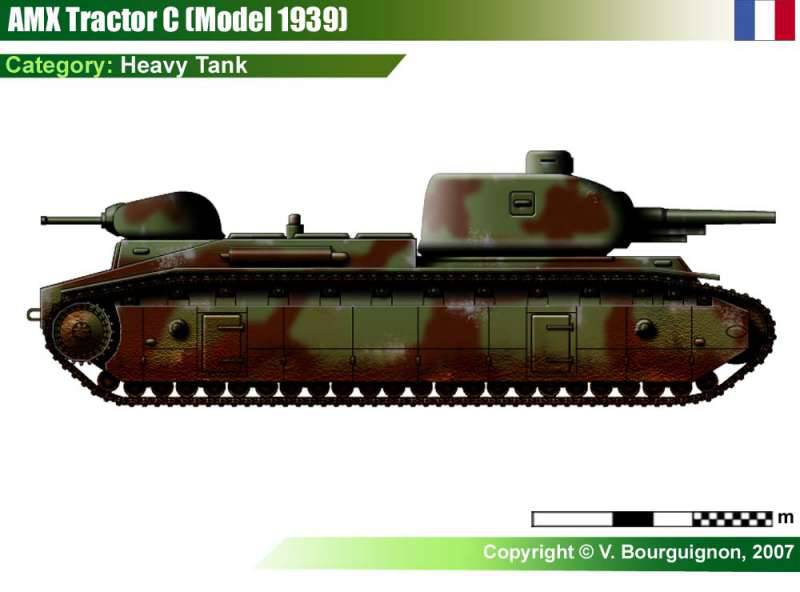
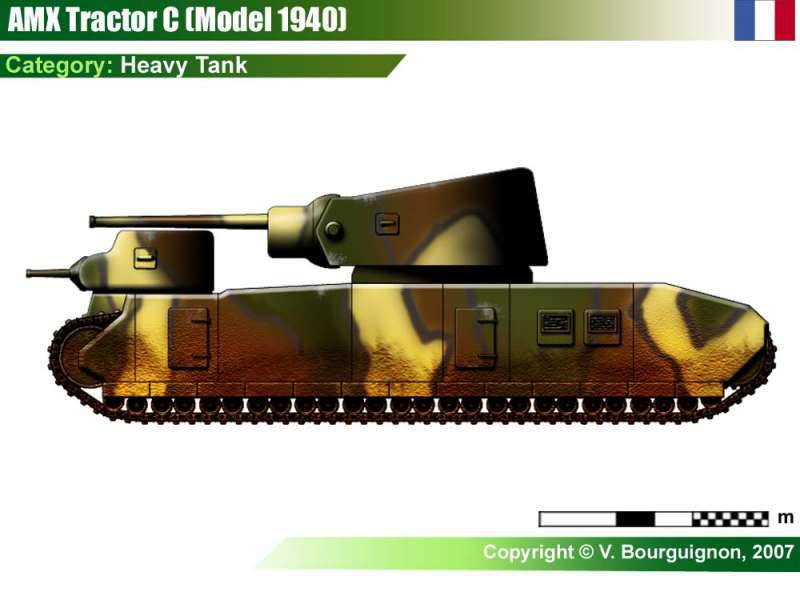
Information